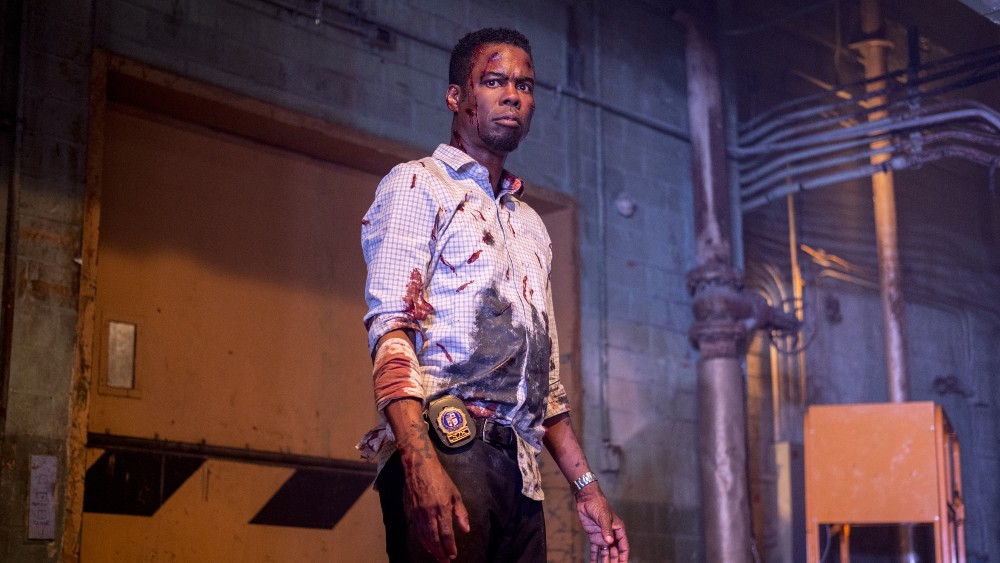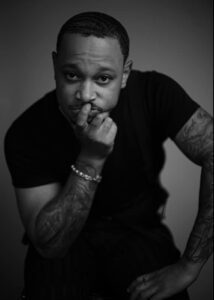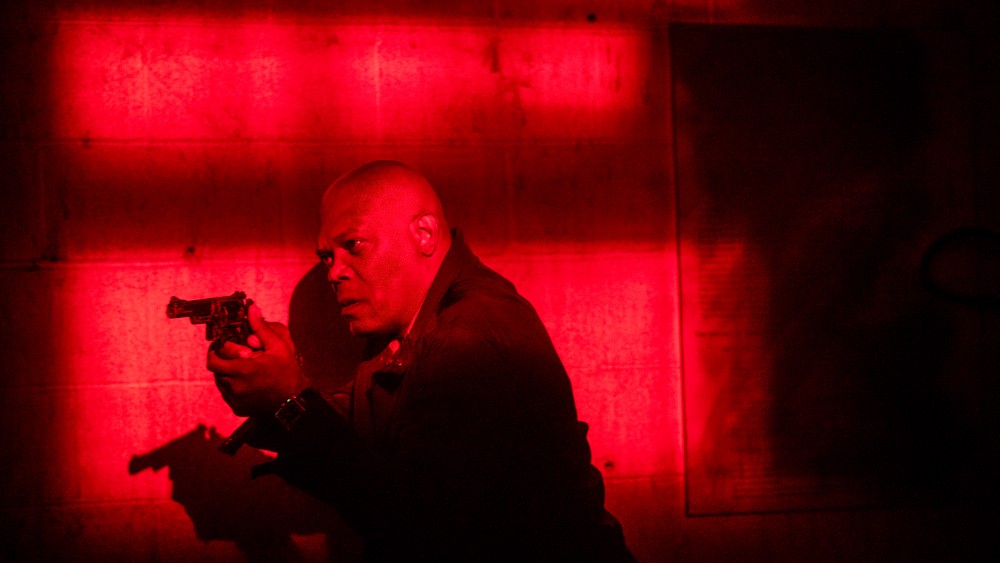
Jordan Oram is a young up and comer, originally from Toronto, who is just breaking into long-form features as a cinematographer, coming from the world of music videos, like Drake’s “God’s Plan.” Due to the quality of his earlier work, Oram managed to score the gig shooting Lionsgate’s new incarnation of the Saw franchise: Spiral: From the Book of Saw, starring Chris Rock and Samuel L. Jackson.
If you read our review, you’ll already know that this Saw movie looks very different from the eight previous ones, despite it marking the return of Director Darren Lynn Bousman. That’s just one of the things Below the Line discussed with Mr. Oram when we got on the phone with him last week to talk about Spiral and how that’s leading to a burgeoning career as a cinematographer.
Below the Line: Before we get into Spiral, I’d love to find out more about your background. Did you go to school for film?
Jordan Oram: No, I actually dropped out of college. I was in school for business management and marketing, and I went off to be a travel agent. I didn’t have a marketing department, so I started to do camera work. I wanted to kind of excel in the world of movies, and instead of doing music videos, I just wanted to kind of up my work ethic. So I got a mentor and did the ranks and worked my way up to where I’m at after the course of over the last 10 years or so. Just working, finding mentors, asking questions, trying and failing and then realizing that that’s how you create your style is you have to kind of fail by yourself. Sometimes, people forget that you can’t ask questions and figure out who you are as an artist. You have to figure out who you are as an artist by the mistakes that you make.
BTL: It’s great to hear from cinematographers who have worked up the ranks doing different jobs, including key grip.
Oram: Yeah, I’ve done it all.

BTL: I assume you kind of have to, because as a cinematographer, you’re in charge of all of those sub-departments and have to know how to talk to them in their language.
Oram: Yeah, you have to. It’s great, because of the relationship I have with my team, I’m not like a dictator. I tell them what I want, but also, because I’ve been there before, it’s more collaborative, so it’s easier for me to suggest things that I want, because I’m not someone that’s just like, “Yeah, I want a good light or I want this fabric or this swag or this camera position. No, this is why I want this specific tool. And more often than not, although I’m young, I’m very educated, so it’s nice to work with older people in the industry, because I’m teaching them about new forms of technology, new tools. And that’s great. It’s like a respect level all the way across.
BTL: How did Darren or Chris Rock or Lionsgate reach out to you, and what was your audition process like to shoot to film?
Oram: I’ve heard the stories about how Darren found me, and I always hear the story that he saw a couple of music videos that he really enjoyed — one being Drake’s “God’s Plan” that I did cinematography for. He just wanted me; he just wanted the guy that did the cool music videos. He called my agent, and I went in for the interview and I didn’t really know what I was really walking into. I knew I was meeting with the director of Saw II, III and IV, but I didn’t walk into a new ninth iteration of the Saw franchise. When I walked into his office, he just mentioned that he was really excited to meet me and he would love the opportunity to work with me, and so it took a lot of pressure off my back, and I wanted to really step up from music video. It really stepped me into this industry of long-form narrative work and especially the Saw franchise.
BTL: Had you seen all the Saw movies before? Now have you seen all the movies before Have
Oram: I had seen Saw I, II, and III, and then I went back and watched all of them — IV, V, VI, VII and VIII — just for my own personal archival knowledge and just really understand what I was going to be making and what I was not going to be replicating. I knew that the ask of Darren from the studio was to make something that was going to be looked at as something that could be cool, something interesting, something fresh, a new take on this franchise. So for me, I just asked for permission to kind of break all those rules that hadn’t been broken, because they were following the same formula. For me, every decision I was making was definitely to really spark crowd and group think. I wanted to make sure that the things that I was invoking in Darren, and in the studio, were accepted, especially amongst the community of the franchise for years.
BTL: As I was watching it, one of the main things I was looking for was how it was going to be different than the other movies, since I had seen all of the Saw movies, and all of Darren’s movies, but I know that David Armstrong shot all the other movies and Kevin Greutert edited most of them, so they did have the same look.
Oram: The iconic 360 edit.
BTL: This is definitely the best looking of the films, and I realized that there were far more locations on this vs. stage work.
Oram: Yeah, that was a major difference. This was the first film that wasn’t shot all in studio. This is the first time Saw has actually been in the real world. So for me, it was a great privilege to sit down with Darren, and ask him out if it’s gonna be different. The first thing he said is that he wanted to make this film on the hottest day of the summer. So automatically, I drew inspiration from films like Do the Right Thing and Seven. I really wanted to kind of juxtapose the color palette with a monochromatic palette, whereas having vibrant colors was drawing too much attention to itself. So I made it a really big thing for me to just use my music video background, and to filter the effect of what the camera was being able to capture in color contrast, and really work with wardrobe and set design to really ensure that all the colors that we’re putting in front of the camera, were going to complement each other, but not fight for attention. They would all kind of sit within the same palette. So everything was intentionally warmed up. We intentionally use practical sources and warm tungsten lighting, to kind of keep this natural color and this natural warmth, that you constancy throughout the film. Each set has its own world. So we live in a different palette and every space that you go in, and it’s going to be comfortable for many people because it looks rich to your eyes. So you’re gonna get sweat, you’re gonna get armpit jules, you’re gonna get crowded areas, you’re gonna get texture on the windows and on the walls. Everywhere you look, there’s gonna be something to draw your eye in, because that’s what Saw does. It always keeps you on the edge of your toes so it’s always busy. This is the first time and I think we’ve seen the Saw franchise in a world where it’s Saw in 2021. It’s beautiful.
BTL: Was all of this shot in Toronto?
Oram: Yeah, we shot everything in Toronto.
BTL: I recognized the subway stations, so do you do a lot of your work in Toronto?
Oram: No, I actually don’t work in Toronto as much. For the last couple of years, I’ve been working in Toronto quite more, mainly because I want to make sure that Canada really sees me for Canadian talent, not just south of the border. Picking the camera team was a little bit different for me. This is my first union job, IATSE 667, so I wasn’t a part of the union till I got the call for Spiral and then they gave me a reference letter and got me into the union. Getting to know everybody and meet everyone, meeting my gaffer and meeting my camera team, it was all from the recommendations from the mentors that I’d been working with over the years to say, “Hey, these are the people that I’m considering, what do you think?” So I had to really entrust the community that I’ve been putting myself in to really help me guide my path through the next trajectory of my career. It wasn’t really challenging, getting to know the new steps — it was just something that I had to adopt as fast as possible. As like everything else in my career, I was thrown into positions where I wasn’t really technically on paper ready for, but mentally, I’ve been preparing for it my whole life. It had been in the natural progression to the seat of being cinematographer of this movie.
BTL: What was involved with putting together your camera team? I’m not sure how big your team was compared to the ones for making music videos.
Oram: Weirdly enough, I have about the same size of a team working on a music video that I do working on a feature film, so it’s kinda ironic that the music videos that I’d been doing, I’m comfortable working with a budget that’s well over a million dollars, but with a team of 40 to 50 people all working on the same product. I was kind of aware of the process of it, but the difference here is that you work with different departments, so you’re not just working with the director or the production designer or the hair makeup wardrobe, you’re also working with logistics, you’re also working with production design. You’re working with every department a little more hands-on and a longer form of time, pre-COVID. So you really get to know your team, and it’s not just from job to job to job to job. You’re really developing a family trust with your team in long format.
BTL: Is Darren pretty up on lenses and gear and stuff?
Oram: No, no, Darren’s not technical at all, which is why I think our relationship together was so beautiful, because I am. He didn’t want to kind of speak the jargon, he just wanted a cool thing. He knew what he wanted, but he just wanted me to do what he hired me to do. So I got to really educate him on why we were doing things, and he said, “Okay, if that’s what you want to do, if that’s where your gut is….” I would show it to him, and he would sign off on the shots that we would talk about. Ultimately, we were definitely aligned on what was needed. He wanted to make these shots breathe, he wanted them long. Architecturally, he wanted long takes. So that scene coming out of the hotel room, that would go down to the elevator and the cops would open up the door and bust Chris in the car, that was actually a one-take shot that got cut down in the edit. It was like a seven-minute shot that we spent all day rehearsing, and it was an amazing shot that Darren architected the whole way through. It’s those shots and that level of thinking that for me excites me because someone like Darren, his mind’s moving at a million miles a minute. So for me to be able to retain all that information digest it and then regurgitate it back to him, we were able to just bounce ideas off of each other so quickly, because we didn’t need time to digest, because we understood how fast our brains were working, which is I think the duality of our relationship.

BTL: How long was this shoot by the way?
Oram: Yeah, we shot for 36 days in Toronto.
BTL: Do you know how that compares to the other movies? I know Darren came on for the second movie which had more money than the first one, and I think that was the case with each successive movie.
Oram: Yeah, I think this was the longest they’d ever shot. I think the last couple Saw movies were 22, 25, 28 days? This was definitely the longest filming.
BTL: Of course, I want to ask about filming the traps or puzzles which involve a lot of close-up work and footage that’s needed because there’s a lot of editing is involved.
Oram: Yeah, a lot of choosing the shots, choosing the frame, choosing the angle, really works with story. So I sit down with Darren and go through the scenes and really say to him, “What do you want to say for the scene? How does this trap work? How does this gag work? What do you want to see first?” So for us, two cameras, two camera teams, and we really sit down and say to ourselves, “How do we want to break this up for the day? How are we going to schedule our stunts?” because you want to get the meat and the potatoes of the stunt done first, so that you can actually spend the time developing the scene. That way the trap has enough time to be developed, and we have time to reset. So you have to start with a trap first. Do the trap, get into the scene while this trap is resetting and then go back to the trap. And then you can do something different on each take. Having two cameras working at all times, you’re able to pick two frames that can kind of work cohesively together.
BTL: I assume you can’t keep the actors in the trap for too long either, since they’re probably uncomfortable even if they’re not being killed.
Oram: Oh, not at all. I’ll tell you right now you don’t want to have Samuel Jackson hanging from the ceiling for 15 minutes.
BTL: Is all of that stuff storyboarded in advance?
Oram: Yeah, yeah, all the traps are storyboarded, and it’s kind of plug and play, so there’s really no guessing when you’re dealing with Saw trap, that’s the bread and butter. A lot of time was spent orchestrating and architecting the actual trap and making sure that it was safe for everybody to step into, as well as the gore had to be top-notch, seeing as Josh Stolberg really knows how he wants his traps to come off. I think having that conversation with everybody ahead of time, saying how gruesome is this going to be or how witty is this one? Or does this make sense being part of the Saw Universe of traps? That’s a whole movie in itself, just on how these masterminds create these traps.
BTL: Obviously, you hadn’t worked with Chris Rock or Sam Jackson before this, and they’re both master improvisers, so does a lot of things change when they get on set?
Oram: Yeah, for me, it really uses a level of professionalism and also just was really incredible for them to see someone like me, BIPOC, behind the camera in this type of environment. So for me, just the level of professionalism they bring, and everyone comes with their A-game on set. So no matter what you’re doing or what you’re saying they’re respecting your time, they’re respecting your energy, respecting your efforts. They also give back to the other actors and their other counterparts on the floor. So if there’s a line of dialogue or two they’re not getting, they spend a little bit more time and they kind of work with everybody. So everyone kind of listens when one or two or three or four are talking, and it’s really just a matter of them stepping into that role of who they are, and everyone else kind of following suit. Because it’s Chris Rock and Samuel L. Jackson, and they are major, major stars in all of our lives. We just want to enjoy the attention that we’re all kind of there to make a movie, so we’re all there to figure out the same problems.
BTL: Do either of them watch back takes to see what they’re doing?
Oram: No, they never do. There were moments when Chris wanted to just see if his jokes were funny, because some of the things that he said in the film were improv-ed, but he would go back and reset and he’d do another version of the joke, and it would just progressively get funnier. But then he would get to a point where we just stopped the camera because everyone was laughing. It was a natural thing that was happening without us even asking, like the whole Jamaican patty scene. There’s multiple moments in that movie that were not scripted that ended up just becoming something authentic to what Chris was saying in the moment.

BTL: I have to ask what this movie City of Sleep is, because I notice that both you and Editor Dev Singh worked on that either before or after Spiral.
Oram: No, Dev Singh is my guy, man. He edited my very first feature film, and I actually recommended him for the job for Spiral, so he ended up getting on because he ended up editing my first feature film that I shot in Winnipeg, and when they were looking for an editor, I was like, “Well, I worked with this guy who had the best workflow that I’ve ever seen. So if you’re interested in meeting him…” They met with him and I think he got the job right away. Because of his organization, the way that he saw the franchise was very similar to my approach. He just wanted to make something that was organic, that was rich and came from that background of long-form narrative, but also came from music video and had the capability and the capacity to really make something that was unique and work alongside Darren, who is a long avid editor of his movies.
BTL: Is that movie coming out or did it come out already?
Oram: It’s in the festival circuit right now. It should be coming out of the festival, I think at the end of next year.
BTL: I assume you’ve been working since the pandemic began?
Oram: Oh, yeah, I’ve been working on stuff.
BTL: What’s that experience been like? I’ve spoken to a few cinematographers who are not fans of the face shields and how it affects their vision.
Oram: I dislike it, but you know what? As long as everybody’s safe, and we’re all continuing to work. I’m just grateful I could actually do this, so I’ve been working, but I think ultimately, I’ve also been trying to assure myself that I’m staying healthy and staying happy, and I’m staying grounded in the reality of this pandemic, just ensuring that everyone is protected, and everyone knows that we just have to slow down and make sure we’re protecting ourselves, washing your hands and keeping everything safe on and off set when we’re not working.
BTL: I spoke to a costume designer earlier, and she said that the one thing she’d like to continue is the cleanliness and the washing of hands, since that stuff doesn’t hurt to do anyway.
Oram: Yeah, it’s crazy to realize how many people don’t wash their hands and then you start seeing how much sanitizer. You look at a bottle of hand sanitizer in their office for a week, and how much of it did they use?
BTL: Is there anything that you’re working on that you can talk about?
Oram: Yeah, I’m working on a TV series called The Porter right now in Winnipeg. It’s a 1920s episodic TV series for CBC and BET collaborative, directed by R.T. Thorne and Charles Officer. Very exciting, it’s my first TV series, eight episodes, an hour apiece. There’s a couple of features that I’ve got in the pipeline that I haven’t really confirmed yet. But they’re definitely noteworthy, and I’m excited to see if they land, because as the follow-up to Spiral, I’ve been getting a lot of inquiries and reading a lot of scripts. I never thought that Spiral was gonna get me half the calls that I am having in the last couple of months.
BTL: Were you able to include Spiral as part of your reel since the movie was done and supposed to come out last year?
Oram: No, I wasn’t. It was even more frustrating, because the first trailer that they put out was not color-corrected. So the second version of the trailer that came out a couple of weeks ago, was the colored version, and that’s the one that everyone’s seen and contacting me for, because it was such a better trailer, and it was colored. So I got to see the material the way that I intended the material to look, and the response was just exactly what it needed to be. It was like, “This looks great!”
Spiral is now playing in theaters nationwide. All photos courtesy of Lionsgate; Photographer Brooke Palmer.






